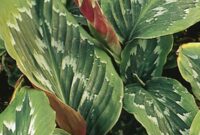I. Introduction
Vinca Leaves and the Mysterious Yellowing
When you glance at your garden, you expect to see a burst of green, especially from your beloved Vinca plants.
These resilient and vibrant perennials are known for their beautiful, evergreen foliage.
However, if you’ve noticed that the leaves of your Vinca are slowly transitioning from lush green to a concerning shade of yellow, you’re not alone.
It’s a predicament many gardeners face, and it’s essential to understand why this color change occurs.
The Vital Role of Healthy Foliage
Healthy foliage is the lifeblood of any plant, and Vinca is no exception. Those lush, green leaves not only contribute to the plant’s aesthetic appeal but also play a pivotal role in its overall well-being.
They are the primary sites for photosynthesis, the magical process by which plants convert sunlight into energy to fuel their growth and bloom.
Exploring Common Causes and Solutions
In this blog, we’re delving into the intriguing world of Vinca leaves turning yellow.
We’ll uncover the most common culprits behind this phenomenon and, more importantly, provide you with practical solutions to nurse your Vinca plants back to their vibrant green glory.
Whether you’re a seasoned gardener or just getting started, understanding the reasons behind yellowing Vinca leaves is the first step towards ensuring your garden stays lush and vibrant throughout the growing season.
II. Understanding Vinca Plants
Vinca: More Than Just Pretty Flowers
Vinca, scientifically known as Vinca minor, is a delightful and versatile addition to gardens around the world.
This evergreen perennial is cherished for its unique combination of features that make it a favorite among gardeners of all levels of experience.
Vinca’s Endearing Characteristics
Vinca plants are best known for their small, five-petaled flowers, which can bloom in a variety of colors, including purple, lavender, and white.
These charming blooms add a burst of color to gardens, making Vinca a popular choice for borders, ground cover, or container gardens.
But Vinca offers more than just beautiful blossoms; it’s also loved for its:
- Lush, Glossy Foliage: Vinca leaves are typically dark green and glossy, creating a lush carpet that beautifully complements its colorful flowers.
- Low Maintenance: Vinca is prized for its low-maintenance nature. It’s known to thrive in various soil types and can adapt to both sun and shade, making it an ideal choice for a range of garden settings.
- Versatility: Whether you’re landscaping your front yard or adding accents to your backyard oasis, Vinca’s adaptability and hardiness make it a reliable choice.
The Importance of Vibrant Green Leaves
Now, let’s zoom in on those leaves. While Vinca’s flowers steal the spotlight, the significance of its foliage should not be underestimated.
The green, vibrant leaves are the backbone of Vinca’s appeal. Here’s why they matter so much:
1. Photosynthesis Hub
The leaves of Vinca are the powerhouses of the plant. Through a process called photosynthesis, they capture sunlight and transform it into energy.
This energy fuels the plant’s growth, including the production of those gorgeous flowers you adore. In essence, the leaves are like the plant’s solar panels, essential for its vitality.
2. Aesthetic Appeal
Beyond their functional role, the deep green leaves of Vinca provide a striking contrast to the colorful flowers.
They serve as a backdrop that enhances the visual impact of the blooms, creating a harmonious and pleasing garden display.
In the next sections, we’ll unravel the reasons why these leaves may start to lose their vibrant green hue and explore how to restore them to their full glory.
But before we do that, let’s understand the common factors that lead to yellowing leaves in Vinca plants.
III. Common Causes of Yellowing Vinca Leaves
As you’ve observed, the transformation of vibrant green Vinca leaves into a worrisome yellow hue can be disheartening.
To better understand why this occurs, let’s explore the various factors that contribute to the yellowing of Vinca leaves.
Identifying these causes is crucial to effectively address the issue and restore your Vinca’s health.
1. Overwatering: The Soggy Predicament
The Pitfall of Excessive Moisture
Overwatering is a common mistake that can lead to yellowing leaves in Vinca plants. Vinca prefers well-drained soil and can be susceptible to root rot if it’s constantly sitting in waterlogged conditions.
When roots struggle to breathe due to waterlogged soil, it can impede their ability to absorb essential nutrients and oxygen, resulting in yellowing leaves.
To prevent overwatering, ensure that your Vinca is planted in well-draining soil and adjust your watering schedule to allow the soil to dry out slightly between waterings.
2. Soil Issues: The Foundation of Plant Health
How Poor Soil Conditions Impact Vinca
The health of your Vinca plants is greatly influenced by the soil they inhabit. Poor soil conditions can lead to nutrient imbalances, which in turn can cause yellowing leaves.
Compacted or clayey soils can hinder proper root growth and reduce the plant’s ability to take up nutrients.
To address this, consider amending the soil with organic matter to improve its texture and nutrient content.
This will help create an environment where Vinca can thrive and maintain its lush green foliage.
3. Nutrient Deficiencies: The Hunger for Vital Elements
Understanding the Role of Essential Nutrients
Essential nutrients, such as nitrogen, potassium, and iron, play a vital role in plant growth and leaf color.
A deficiency in any of these nutrients can manifest as yellowing leaves, a condition known as chlorosis. Each nutrient deficiency may present distinct symptoms, aiding in diagnosis.
4. Pests and Diseases: Uninvited Garden Guests
Common Culprits that Attack Vinca
Vinca plants are not immune to pests and diseases, and some of these garden invaders can cause leaves to turn yellow.
Aphids, spider mites, and certain fungal diseases are known to afflict Vinca leaves, disrupting their health and color.
In the coming sections, we’ll identify these troublemakers and discuss methods for preventing and treating pest and disease infestations to preserve your Vinca’s vibrancy.
5. Environmental Stress: Nature’s Challenges
The Impact of Extreme Temperatures and Sunlight
Environmental factors can also play a role in the yellowing of Vinca leaves. Extreme temperatures, whether excessively hot or cold, can stress the plant and affect leaf color.
Additionally, Vinca’s sensitivity to light levels means that inadequate or excessive sunlight can lead to discoloration.
We’ll explore how to shield your Vinca from these environmental stressors and create optimal growing conditions to keep its leaves lush and green.
IV. Solutions and Remedies
Now that we’ve uncovered the common causes behind the yellowing of Vinca leaves, it’s time to roll up our sleeves and explore practical solutions for each of these issues.
1. Proper Watering Techniques: Quenching the Thirst
The Right Way to Water Vinca Plants
To combat the effects of overwatering and ensure your Vinca’s roots stay healthy, it’s crucial to master the art of proper watering. Here’s what you need to do:
- Water Deeply, but Infrequently: Rather than frequent shallow watering, give your Vinca a deep soak once a week. This encourages the development of deep roots that can access water more effectively.
- Use a Soaker Hose or Drip Irrigation: These methods deliver water directly to the soil, reducing the risk of wetting the foliage, which can lead to diseases.
- Mulch Matters: Applying a layer of organic mulch around your Vinca plants helps retain moisture and prevents soil from drying out too quickly.
- Monitor Soil Moisture: Invest in a soil moisture meter to accurately gauge when your Vinca needs water. This takes the guesswork out of watering.
2. Soil Improvement: Nurturing the Foundation
Advice on Enhancing Soil Quality
Improving your soil’s texture and nutrient content is key to Vinca health. Here’s how to do it:
- Add Organic Matter: Incorporate well-rotted compost or organic matter into the soil to improve its structure and nutrient retention.
- Adjust pH Levels: Vinca prefers slightly acidic to neutral soil (pH 6.0-7.0). Use a pH testing kit to determine your soil’s acidity and amend it accordingly.
- Regularly Aerate the Soil: Aerating the soil helps prevent compaction, ensuring that roots have room to breathe and grow.
3. Nutrient Management: Feeding Your Vinca
Fertilization and Addressing Nutrient Deficiencies
To combat nutrient deficiencies and promote healthy green leaves, consider the following steps:
- Choose the Right Fertilizer: Opt for a balanced, slow-release fertilizer formulated for flowering plants. Apply according to package instructions.
- Monitor and Adjust Nutrient Levels: Regularly inspect your Vinca for signs of nutrient deficiency and adjust your fertilizer regimen accordingly.
- Consider Foliar Feeding: In cases of severe nutrient deficiency, foliar feeding with a liquid fertilizer can provide a quick nutrient boost.
4. Pest and Disease Control: Safeguarding Your Vinca
Preventing and Treating Common Issues
To protect your Vinca from pests and diseases, follow these tips:
- Practice Good Garden Hygiene: Remove debris and dead leaves from around your plants to eliminate hiding spots for pests and diseases.
- Use Natural Predators: Introduce beneficial insects like ladybugs or lacewings to your garden to control pest populations.
- Choose Resistant Varieties: When planting Vinca, select disease-resistant varieties to reduce susceptibility.
- Apply Appropriate Pesticides: If necessary, use pesticides as a last resort, opting for eco-friendly options that won’t harm beneficial insects.
5. Environmental Considerations: Shielding Your Vinca
Tips for Protecting Vinca from Adverse Conditions
To safeguard your Vinca from extreme temperatures and light stress, follow these suggestions:
- Provide Shade During Heatwaves: Use shade cloth or strategically placed garden structures to shield your Vinca from intense sunlight during heatwaves.
- Cover Plants During Frost: If frost is expected, cover your Vinca plants with frost cloth or blankets to protect them from cold temperatures.
- Prune for Air Circulation: Properly prune your Vinca to encourage air circulation, reducing the risk of heat and moisture stress.
By implementing these practical solutions, tailored to the specific causes of yellowing in your Vinca, you’ll be well on your way to restoring the vibrancy and health of your beloved garden specimens.
V. Maintenance and Preventive Tips
Keeping Vinca Leaves Healthy for the Long Haul
Maintaining the health and vibrancy of your Vinca plants is an ongoing process that requires a little attention and care.
1. Regular Inspection and Care: Your Gardening Routine
The Importance of Routine
Just as you have a routine for taking care of yourself, your Vinca plants benefit from a regular gardening routine. Here’s how you can make it work:
- Weekly Inspections: Dedicate a few minutes each week to inspect your Vinca plants. Look for any signs of yellowing leaves, pests, or diseases.
- Prompt Action: If you spot any issues during your inspections, take prompt action. Addressing problems early can prevent them from becoming more severe.
- Deadheading: Regularly remove spent flowers (deadheading) to encourage new growth and prevent energy waste on seed production.
- Pruning: Trim your Vinca as needed to maintain a balanced shape and improve air circulation.
2. Creating the Ideal Environment: A Vinca Haven
Tailoring Your Garden Space
To ensure your Vinca thrives, it’s essential to create an environment that caters to its needs:
- Proper Spacing: Plant Vinca with adequate spacing to allow for air circulation, reducing the risk of diseases.
- Mulching Continues: Keep up with mulching to conserve soil moisture and maintain an even soil temperature.
- Mulch Replenishment: Renew mulch as needed to keep it at an appropriate depth of around 2-3 inches.
- Seasonal Maintenance: Adjust your care routine according to the seasons, as Vinca’s needs may change with temperature and light fluctuations.
3. The Last Word: Taking Action
Time to Take Charge
Now that you’re armed with knowledge about the causes of yellowing Vinca leaves and the solutions to combat them, it’s time to take action.
Remember, maintaining the health of your Vinca plants is a rewarding endeavor that brings vibrancy and life to your garden.
As you implement these solutions and incorporate preventive measures into your gardening routine, you’ll not only revive your Vinca’s leaves but also nurture a thriving garden that serves as a testament to your care and dedication.
So, step outside, inspect your Vinca, and create a nurturing environment where these resilient plants can flourish.
Your efforts will be rewarded with a sea of lush green leaves and colorful blossoms that will leave you and your garden guests in awe.
In the end, the health and vitality of your Vinca are in your hands. Take charge, nurture, and watch your garden thrive. Happy gardening!
.
.
.
source image : https://ask2.extension.org/kb/faq.php?id=651679



